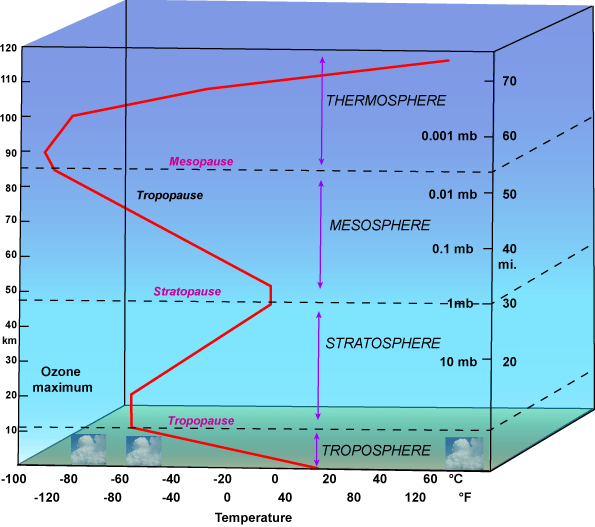
What would be the first climate model to consider? If you take an engineering approach
to global climate? Well, one idea is to start from an observation of the (global mean) temperature distribution through the atmosphere, starting at 15 C at the Earth surface, dropping to -55 C at the tropopause and climbing back to 0 C at the stratopause, as displayed in the above figure.
To this we add the insight that without any atmosphere the effective temperature of the Earth surface can be estimated to be 0 C, as a consequence of Stefan-Boltzmann's Radiation Law assuming that emissivity equals absorbitivity.
This leads to describing the total effect of the atmosphere, as a result of a complex interaction of convection-evaporation/condensation-radiation-conduction, as a change of temperature profile from a flat constant zero profile to the observed V-profile of 15 to - 55 to 0 C.
Suppose now that the combined properties of the atmosphere change by 1%. How much would the temperature profile change? The first guess would be a change of profile by 0.15 to -0.55 to 0 C. In particular, Earth surface temperature could be expected to change by 0.15 C.
A 1% change (of "radiative forcing") is what is commonly attributed to doubling the CO2 in the atmosphere, and the associated climate sensitivity could thus in a first basic approximation be a global warming of 0.15 C, which is not alarming.
We may compare with a simple
application of Stefan-Boltzmann's Radiation Law with a fully opaque atmospheric layer at the assumed reference temperature 255 K with corresponding ground temperature of 2^(1/4) x 255 = 303 K = 30 C. This is too high and adjusting the absorbitivity of the atmosphere we can get any ground temperature between 255 and 303 K, in particular the observed 288 K. Changing then the absorbitivity by 1%, the temperature would change 1% of 303 -255 ~ 0.3 C. SB would thus indicate a climate sensitivity of 0.3 C.
Compare with
ERBE observation indicating a climate sensitivity of less than 0.5 C.
In order to reach the alarming IPCC climate sensitivity prediction of 1.5 - 4.5 C, positive feedback with a factor 5 - 30 is required, which seems way beyond rationale. To get around this alarming threat to climate alarmism, IPCC claims that the basic approximation is not 0.15 C, but instead 1 C as a result of
an even more simplistic application of Stefan-Boltzmann's Radiation Law different from the above. With that starting point, feedback factors of size 2-3 would suffice and alarmism is no longer unthinkable, even if not probable.
We have thus two approaches: One approach based on observation combined with what could be referred to as sound down-to-earth engineering. Another approach without observation based on applying a simple physical law to a complex situation not at all described by the physical law.
Which approach would you prefer as a starting point for a more detailed study, to form the the climate politics of tomorrow? What is the science of feedback factors 0f size 5 - 30?
Compare with increasing the heating in your house by 1% a day with outside temperature 0 C by turning on an extra 40 W lamp, and observing how much the inside temperature in Celsius will rise: 1% or 30%?
Altogether we understand that the entire flow of heat received from the Sun from the Earth
operates on a temperature drop of 15 C from the Earth surface to the stratopause in a complex combination of convection-evaporation/condensation-radiation/conduction. A first mathematical model would connect heat flow linearly to temperature drop according to Fourier's Law. An engineer predicting the heating cost for a house under different outside temperatures, would use Fourier's Law as a first approximation of the complex flow of heat through a wall or window. An engineer relying only an incorrect application of Stefan-Boltzmann's Radiation Law, would not have a job.
Compare also with








